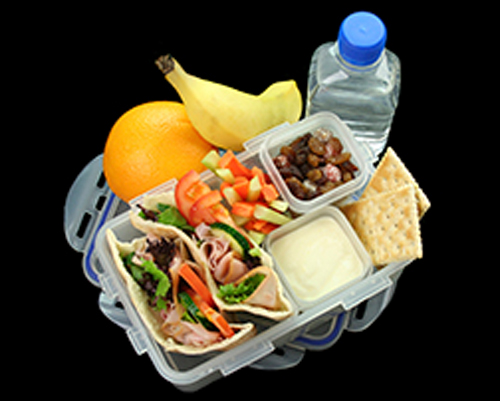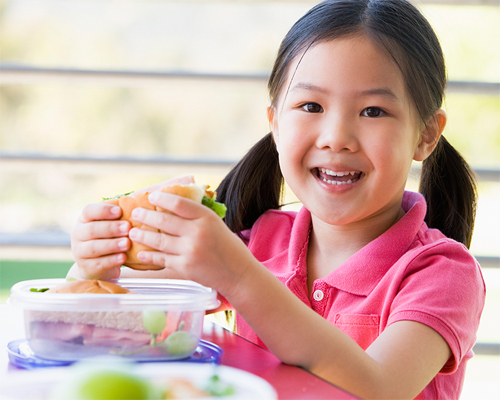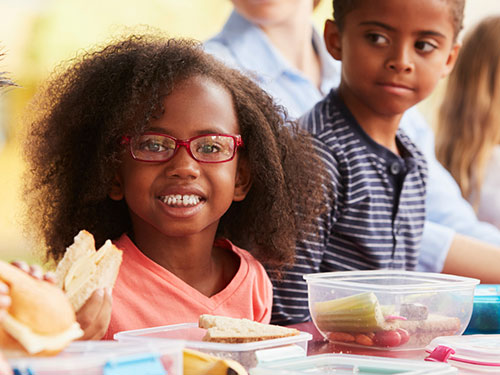
Fact Sheet FS1242
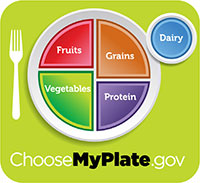
Sending your child to school with a bagged lunch is a good way to ensure that your child has foods she or he likes for lunch; it may also save money. However, some parents struggle to find the right balance of convenience and nutrition. It may be easy to rely on pre-packaged, processed convenience foods, but many of these products are high in sodium, saturated fat, and trans fat and low in the vital nutrients children need to grow into healthy, strong adults, including calcium, fiber, and Vitamins C and A. The good news is that there are plenty of easy, affordable, and nutritious foods you can prepare at home for your child's lunch.
Lunch is an important part of a child's school day. Research shows that students with healthy diets tend to perform better on standardized tests and throughout the academic day. They also tend to have better attendance and fewer behavior issues than children who eat a less healthy diet. Additionally, eating a lunch full of whole grains, fruits and vegetables and protein helps children stay focused and learn new information throughout the day. Outside of school performance, eating a healthy diet helps maintain a healthy weight, which reduces risk for chronic diseases like obesity, cardiovascular disease and diabetes.
A great resource for ideas on packing your child's lunch is MyPlate, the USDA's nutrition guideline depicting the five major food groups (vegetables, fruit, dairy, protein, and grains) that all consumers should aim to eat daily.
To meet MyPlate guidelines, aim to pack a lunch that makes half of your child's "plate" (i.e., lunch) fruits and vegetables, one quarter grains, and one quarter lean protein. By following MyPlate as a guide for planning your child's lunch, you will ensure that your child is meeting the recommended nutrition goals in the Dietary Guidelines for Americans. Give these food group tips a try to build a better lunch.
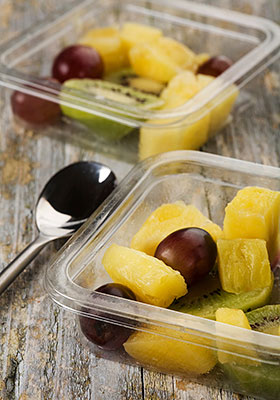
Figure 1.
Fruit
Fresh, Whole Fruit – Fresh fruit is easy-to-pack and keeps well at room temperature. Some kid-friendly favorites include Clementines, small grape bunches, apples and oranges cut into slices, fresh mixed berries, and bananas.
Canned or Plastic Cup Fruit in 100% Juice (No Syrups) – Canned fruit or fruit cups are a convenient way to add fruit to your child's lunch. Choose fruits canned in water or their own juice, not syrup which is high in added sugar. Great options are pineapple tidbits, Mandarin oranges, fruit mixes, applesauce, or peaches.
Dried Fruit – Dried fruit is convenient and does not require refrigeration. Dried fruit pairs well with yogurt, oatmeal, and cottage cheese. It's great by itself, too. Try raisins and other dried fruits, such as dried cranberries ("Craisins"), mango and pineapple. They make a sweet addition to lunch. Look for brands that are low in added sugar.
Apple slices with nut butter and granola – Apple slices topped with nut butter (peanut, almond, & cashew butter) and granola are a great boost of fiber, vitamin C, protein, and healthy fats that will help your child stay focused and energized throughout the school day. If your school has a strict "no nut" allergy policy, try peanut butter alternatives that are also high in protein and healthy fats, like sunflower butter or soybutter. Worried about the cut apples turning brown from air exposure? Dip them in a combination of lemon juice and pineapple juice (1 tablespoon lemon juice to 1 cup pineapple juice) to prevent browning.
Fruit Salad – This is another great option. Pack it plain or top with a tablespoon of fruit-flavored low fat vinaigrette, such as raspberry, and use a lot of colors and varieties of fruits for the most nutrient potential.
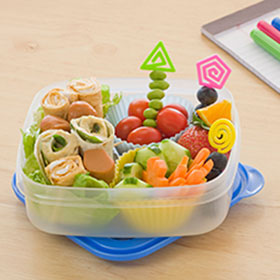
Figure 2.
Vegetables
Fresh vegetables – Cut carrots, zucchini, celery, bell peppers, nd other favorites into strips/sticks for dipping. Veggie sticks are a great "crunchy snack" alternative for chips. Pack dips, such as peanut butter, low-fat ranch dressing, salsa, or hummus with your sticks.
Edamame – Purchase this kid favorite fresh or in the frozen section of your market. Steam it up ahead of time and refrigerate. Kids like to "pop" it out of the pods, but you can also buy the beans already popped and ready-to-eat.
Add "filler veggies" to sandwiches – Grate or chop a variety of vegetables ahead of time and store in your refrigerator. Mix grated veggies into tuna, chicken or egg salad for an added nutrition boost. Top deli sandwiches with the same vegetables. Grated carrots or zucchini and minced celery work well as "filler veggies." Don't forget fresh spinach or lettuce and sliced tomatoes and onions, too!
Salads – Create a unique salad. Start with a base of leafy greens and add different toppings, like Asian-style chicken, light tuna salad, grilled chicken, hard boiled eggs, dried fruits, avocado, strawberries and other berries, apples, sunflower seeds, or other crunchy additions. Be sure to include lots of fresh raw vegetables to give a vitamin boost. Try some "unconventional" vegetable toppings, like edamame, low sodium canned black beans, cherry tomatoes, corn, peas, and red cabbage. Experiment with different lettuces and greens, too. Baby spinach, romaine, and spring mix are mild greens that kids enjoy.
"Shake and Serve" Salads – Pack salad components in a bag or sealed cup with the dressing in a small container on the side. This allows children to add dressing and shake themselves and gets them more involved in their lunch. It also keeps the salad from wilting.
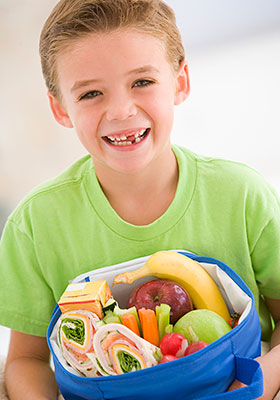
Figure 3.
Grains
Pasta Salads – Use leftover whole grain pasta and fresh cut vegetables, such as bell peppers, tomatoes, onions, and spinach, and mix together with olive oil and garlic or light Italian dressing for a healthy lunch entrée. Select shapes like wagon wheels or spirals for fun.
Crackers – Whole grain crackers with low-fat cream cheese, low-fat spreadable cheese, or peanut butter are a great source of B vitamins and fiber. You can also use crackers to make mini "sandwiches"—use cream cheese & sliced vegetables between two whole grain crackers.
Walking Salad – Wrap your salad in a whole wheat tortilla or pita. Use chopped lettuce and spinach, shredded carrots, diced tomatoes, cucumbers, peppers, beans, and other favorite vegetables. Top with shredded cheese and guacamole or light dressing for added flavor.
Muffins – Muffins can be great source of whole grains. Bake your favorite muffin recipe, but instead of using bleached flour, try whole-wheat flour for a boost of B vitamins and fiber. Try incorporating vegetables and fruit into your muffin recipes too, such as shredded carrots or zucchini, or substitute applesauce for some of the oil. The conversion rate for applesauce to oil is 1 cup to 1 cup, so if your recipe calls for ½ cup of vegetable oil, you can reduce the amount to ¼ cup of vegetable oil and replace the additional ¼ cup with applesauce. Read the nutrition facts label when buying muffins. Some store-bought muffins are very large and often high in sugar, fat and calories and low in whole grains.
Breads for Sandwiches – Choose breads that list 100% whole wheat flour in their ingredients with less than 140 mg of sodium per slice and at least 2 grams of fiber per slice. For more of a variety, try using wraps, pitas, English muffins or rice cakes as a substitute for bread. Whole-wheat wraps are a kid-friendly favorite.
Snacks – Baked whole grain tortilla chips or whole wheat pretzels with salsa and guacamole are a great, crunchy snack to include in lunches.
Whole-Grain Trail Mix – Mix together whole grain square breakfast cereal with low-sugar, dried fruits, sunflower seeds, nuts, and a small amount of dark chocolate candies for a healthy snack that kids love.
Be Active!

Physical activity is an essential component of a healthy lifestyle. In combination with healthy eating, it can help prevent a range of chronic diseases, including heart disease, cancer, and stroke, which are the three leading causes of death. Physical activity helps control weight, builds lean muscle, reduces fat, promotes strong bone, muscle and joint development, and decreases the risk of obesity. Children need 60 minutes of play with moderate to vigorous activity every day to grow up to a healthy weight.
Source: Let's Move! – letsmove.obamawhitehouse.archives.gov/
Protein
Black Bean Wrap – Black beans are a tasty, inexpensive source of lean protein. For a protein-fueled, fun lunch idea, pack black beans with salsa, shredded cheese, and guacamole wrapped in a whole-wheat tortilla or pita.
Hard Boiled Eggs – Eggs are an excellent protein source. Hard-boiled eggs can be fun for kids to crack and peel alone, or try preparing them into egg salad for sandwiches and wraps.
Hummus – Spread a whole wheat tortilla with hummus and top with fresh vegetables, or serve with pita bread and celery and carrot sticks for a protein-fueled, "dipping" lunch for your child.
String Cheese – String cheese is a convenient, protein-packed snack to include in bagged lunches. Be sure to opt for brands with less than 180 milligrams of sodium and less than 3 grams of total fat per serving.
Turkey Wraps with Jam and Bacon – Lean turkey is a great protein source. Try combining it with a teaspoon of low-sugar jam and teaspoon of crumbled bacon for a sweet and salty taste that kids love. Serve with carrot sticks or another veggie.
Chicken, Tuna, or Salmon Salad – Use Greek yogurt or light mayonnaise to make a tasty, lighter version of traditional tuna/chicken salad. For chicken salad, use leftover cooked chicken, or lower sodium/no added salt canned chicken packaged in water, instead of broth. When using canned tuna, select low sodium brands that are packed in water, rather than oil. Look for "light" brands of tuna as opposed to "white", "albacore", "tonno" or "gourmet". Mercury levels are much lower in "light" tuna, which is made from smaller skipjack tuna. Large ocean fish (like albacore tuna) contain higher-than-average amounts of mercury, which is of concern for young growing children. Children under 6 can eat up to three 3-ounce portions per month of "light" canned tuna; older children and adults can eat it once weekly. Or, use canned salmon, prepared similarly to tuna or chicken salad, as an alternative. (For more information on mercury and tuna visit water.epa.gov/scitech/swguidance/fishshellfish/outreach/advice_index.cfm.)
Regardless of which protein you choose, "veggie up" your salad with grated carrots, minced celery, baby spinach/romaine lettuce and diced tomatoes. Add diced apples, raisins, dried cranberries or nuts for a more sophisticated flavor. Serve on a whole wheat pita.
Dairy
Yogurt – Supermarkets offer a wide variety of kid's yogurts, but be careful when selecting. Many are high in added sugar. Read labels; select yogurts with less than 13 grams of sugar per serving. Greek yogurts with fruit on the bottom offer added vitamins and protein. They tend to be sweeter and smoother, which kids love.
Low-Fat Milk – If your school doesn't sell it, pack the beverages of choice: water, or low- or fat-free milk.
Cheese – Low-fat cheeses, such as cheddar, Swiss and mozzarella are great on sandwiches and salads, and string cheeses make a tasty way to add calcium and Vitamin D that kids need. Try cottage cheese with dried or fresh fruit, as well.
Pudding – Kids love low-fat pudding. Look for brands that are lower in added sugar, preferably less than 13 grams, as an occasional sweet-treat. Some do not need to be kept cold, but others do, so read the label.
What About...?
Treats – It's tempting to add a special treat to your child's lunch. Whether it's cookies, chips or candy, be prudent. Give treats once in a while, not every day. Limit portion size or the amount you pack—say...1 or 2 cookies or a small snack bag of chips. Read food labels. Choose lower fat, sugar and sodium products, like pretzels or baked chips instead of regular chips.
Food Safety – Keep your child healthy with some basic food safety strategies. Use insulated lunch boxes/bags and cold packs to keep cold food cold. Pack hot foods in thermal containers to maintain heat. Toss any uneaten hot or cold food that your child doesn't eat to prevent foodborne illness. Clean lunch boxes regularly with soap and water. And, encourage your child to wash hands before eating. Whether lunch is after a class or after recess, kids need to wash with soap and warm water before eating. Hand sanitizer is helpful in a pinch. But, remember; sanitizer doesn't work on dirty hands.
For More Information...
Family and Community Health Sciences (FCHS) works with families, schools and communities to promote healthy eating and healthy lifestyles. Visit growhealthy.rutgers.edu/ for information on Grow Healthy, FCHS's garden-enhanced school wellness initiative. Learn how you can bring the Grow Healthy initiative to your school.
Check out these other valuable sites:
Sesame Kale Salad
- Remove stems from kale, cut leaves into small pieces.
- Grate carrots and cucumber.
- Mix together dressing ingredients: sesame oil, miso paste, and vinegar.
- Massage dressing into kale for 2-3 minutes (This is key! It makes the kale more tender.)
- Add in sesame seeds, carrots, and cucumber.
Source: FoodCorps New Jersey
Homemade Hummus
- Bake sweet potato in the oven for 400 degrees F for one hour, or until fork pierces it easily.
- Drain and rinse chickpeas with water. Add all the ingredients to a food processor or blender. Blend until smooth.
- Use as a dip for fresh veggies, or as a sandwich spread.
Source: FoodCorps New Jersey
April 2015
Copyright © 2024 Rutgers, The State University of New Jersey. All rights reserved.
For more information: njaes.rutgers.edu.
Cooperating Agencies: Rutgers, The State University of New Jersey, U.S. Department of Agriculture, and Boards of County Commissioners. Rutgers Cooperative Extension, a unit of the Rutgers New Jersey Agricultural Experiment Station, is an equal opportunity program provider and employer.


